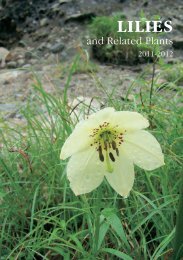LILIES - RHS Lily Group
LILIES - RHS Lily Group
LILIES - RHS Lily Group
You also want an ePaper? Increase the reach of your titles
YUMPU automatically turns print PDFs into web optimized ePapers that Google loves.
The initial task was to transfer, long-hand, all 23 000 daffodil cultivar names<br />
from Moore’s “Modern Method of Filing” (1950s?) on to index cards: this later<br />
formed the basis of the computerized Daffodil Checklist (1989). Earlier daffodil<br />
classifications had to be up-dated and the colour-coding system incorporated.<br />
Working with a horticultural classification system which has been evolving since<br />
1908, has helped me understand present lily classification. There were later<br />
spells as Assistant Editor for the <strong>RHS</strong> and Head Gardener for London House for<br />
Overseas Graduates, before we moved to Scotland.<br />
Over the next 15 years I looked after the family and made gardens, and<br />
developed our collection of pre-1930 daffodil cultivars. Collecting, cultivating<br />
and maintaining detailed records on a database is ongoing. An occasional stint in<br />
the RBG library invariably unearths illustrations (invaluable for the identification<br />
of cultivars) and further nuggets of useful information – as it turns out, ideal<br />
experience for lily registration work. Old daffodils have been identified for both<br />
National Trusts, private estates and individuals.<br />
We have lived barely two years on the croft, where the majestic stems of<br />
Cardiocrinum giganteum are immense, although vulnerable to summer gales.<br />
To help us get to know the genus better, we intend to grow as wide a range of<br />
lilies here as possible, given the constraints of time (bringing rough pasture into<br />
cultivation is a gradual process), climate (very wet, very windy, but relatively<br />
mild), and soil (the raised-beach portion, derived from Torridonian sandstone, is<br />
stony, extremely acid, but surprisingly fertile).<br />
Our predecessor, Vicki Matthews, who has postponed retirement in order to<br />
work tirelessly on the completion of the fourth edition of the International <strong>Lily</strong><br />
Register, was full-time, being both lily and clematis registrar. When we asked<br />
the <strong>RHS</strong> whether we could submit a joint application to job-share, the Society<br />
kindly consented. It is immensely reassuring to have an in-house colleague who<br />
has decades of experience running an office. Although Duncan is principally<br />
the registrar for clematis, lilies generate more work, so he works on lilies too:<br />
for instance, he has written the lion’s share of the lily descriptions for the 1 st<br />
Supplement of the new Register; tends to deal with computer-related issues and<br />
ensures the smooth day-to-day running of our “office”.<br />
We value our registration work highly: it is not only our source of income, but<br />
enables us to keep a foot in the busy world which most people inhabit. Through<br />
working for the <strong>RHS</strong> we have reinvigorated old friendships and hope to forge<br />
new ones. We look forward to corresponding with lily and clematis enthusiasts.<br />
Twenty years ago, the daffodil registrar’s office was a table in the far reaches<br />
of the stack room of the original Lindley Library, beneath a grimy window to<br />
which clung sooty remnants of war-time black-out tape, with views of dreary but<br />
imposing tower blocks. Today, I look towards the sweeping mountain-scape<br />
124




